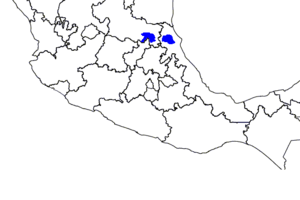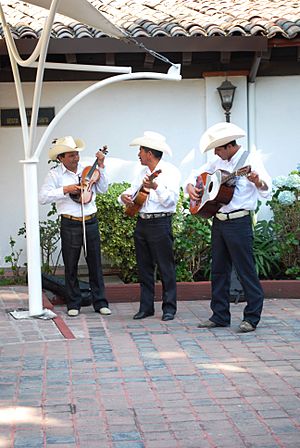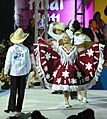Huasteca facts for kids
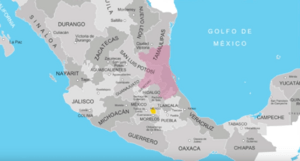
La Huasteca is a special area in Mexico. It stretches along the Gulf of Mexico and includes parts of seven states: Tamaulipas, Veracruz, Puebla, Hidalgo, San Luis Potosí, Querétaro and Guanajuato. This region is named after the Huastec people, who were very powerful here a long time ago.
Even though the Huastec people don't live in all of this area anymore, many people who live here share similar traditions. They have a special style of music and dance, and they celebrate unique festivals like Xantolo.
Contents
Exploring La Huasteca's Geography
The Huasteca region is huge, covering about 32,000 square kilometers. It stretches from the Sierra Madre Oriental mountains all the way to the Gulf of Mexico. You'll find flat lands in the north and east, and sandy hills in the south.
The western parts of the region have tall, uniquely shaped mountains with steep slopes. Eight fast-flowing rivers cut through these mountains. Most of these rivers flow into the Pánuco or the Cazones River, eventually reaching the Gulf of Mexico.
Amazing Caves and Waterfalls
Because the rocks in the mountains are easily worn away, the area is full of caves and underground tunnels. The most famous is the Sótano de las Golondrinas (Cave of Swallows). It's a giant hole in the ground, 372 meters deep! Many birds, like swifts and green parrots, fly out of it in the morning and return at night. It's also a popular spot for base-jumping.
Many rivers here are crystal clear or turquoise blue, flowing through deep canyons and forming beautiful waterfalls. The tallest waterfall is Tamul, which is 300 meters wide and 105 meters tall. Another important waterfall is Tamasopo. At the Nacimiento del Río Huichihuayán, water comes right out of the mountains, creating pools perfect for swimming.
Plants and Animals of the Huasteca
This region is one of the most diverse places in Mexico for plants, with over 2,000 different kinds! It's mostly covered by tropical rainforests, some of which are still untouched. The climate is hot and humid. You can find huge trees like kapok, cedar, and ebony. Along the coast, palms are very common.
The Huasteca is also home to many animals. You might see colorful parrots, macaws, spider monkeys, owls, eagles, toucans, deer, jaguars, wild boars, and raccoons. There are also many types of reptiles and insects.
Main Cities and Sub-regions
The biggest city in the San Luis Potosí part of the Huasteca is Ciudad Valles. In Hidalgo, the most important city is Huejutla. Other key towns include Tantoyuca and Tamazunchale.
One special part of the Huasteca is called the Sierra Gorda. It's mainly in northern Querétaro but also stretches into Hidalgo and Guanajuato. The Huasteca region is divided into smaller parts based on the states they are in, like the Huasteca Veracruzana (in Veracruz) or Huasteca Potosina (in San Luis Potosí). Each part has its own unique features and towns.
Climate in La Huasteca
The Huasteca region is mostly low and has a hot climate. It's generally hot and humid, with temperatures usually between 22 and 26 degrees Celsius. There's a lot of rain because of moisture from the Gulf of Mexico, usually between 800 and 1600 mm per year. However, sometimes there are droughts, which can cause problems for farmers. Hail and hurricanes happen every year.
A Look at Huasteca's Past
The name "Huasteca" comes from the Nahuatl word "Kuextlan." The Huastecs were the northernmost group of people in Mesoamerica (an ancient cultural area in Mexico and Central America). They had contact with the Chichimeca people, which influenced their culture.
The Huastecs were likely related to the Mayans who moved north along the coast. They became very important in their region between 750 and 800 CE. They expanded their land and influence until the 15th century. They built small cities and special centers, but they were never as big or complex as other Mesoamerican cities. This might be because the Chichimeca people were always a threat.
Arrival of New Peoples
Over time, other groups like the Nahuas, Tepehuas, Totonacs, and Otomis moved into the Huasteca region. The Aztec Empire also conquered parts of the Huasteca in the 1400s.
European Arrival and Changes
The first Europeans arrived in the Huasteca region around 1498. After the Spanish conquered the Aztecs, they took control of the Huasteca. Many native people were forced to move or died from war and disease. The Spanish also brought cattle, which changed the land, and introduced African slaves.
Over the centuries, the region changed a lot. Many communities became home to "mestizos" (people of mixed European and indigenous heritage). Today, the original Huastec people live in a smaller area, mainly in Querétaro and Veracruz.
Modern Developments
In the 20th century, roads and other ways to connect the Huasteca to the rest of Mexico were built. This made it easier for young people to leave and find work elsewhere. Schools were also built, which helped more people learn to read and speak Spanish. This also brought new ideas and information to the region.
There's also been a long-standing idea to create a new state called the Huastec State. People who support this believe the region has been ignored by its current state governments. They want to bring together the different cultures and people of the Huasteca into one new federal state.
People of La Huasteca
La Huasteca is home to six different indigenous groups, with over 250,000 people speaking various native languages. About 70% speak Nahuatl, 20% speak Huastec, and smaller numbers speak Otomi, Pame, Tepehua, and Totonac.
Most indigenous communities here are farmers, with corn being the most important crop. They also raise cattle, process sugar cane, and grow citrus fruits. These communities often have their own ways of governing themselves, even though they are part of larger municipalities.
The Huastec People Today
Even though the region is named after them, the Huastec people now live in a smaller strip of land. They are a Mayan people, and their language separated from other Mayan languages about 3,000 years ago. Their culture is unique because they had contact with the Chichimeca people and were separated from other Mayan groups.
Nahua Influence
The Nahua people and their language, Nahuatl, are now the most common indigenous group in La Huasteca, especially in the south and west. Many Nahuas in the southern Huasteca might have originally been Huastecs whose language changed over time.
Culture and Traditions
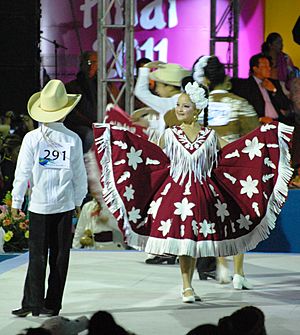
The Huasteca region has a strong cultural identity. This is celebrated at festivals like the Encuentro de las Huastecas. The region's culture has stayed unique because it was quite isolated for a long time.
Huapango Music and Dance
The most traditional music and dance here is called Huapango or Son Huasteco. It's played by three musicians: one on a small five-string guitar (jarana huasteca), one on an eight-string bass guitar (quinta huapanguera), and one playing a violin. The guitarists sing short poems, taking turns. Huapango music is known for its fancy violin parts and the use of a high singing voice.
The dance is performed on a raised platform called a "zapatea." Dancers tap their feet to the rhythm. This music and dance style is loved by all the different groups in the region. It's often performed at rural social events called "fandangos."
Delicious Food and Xantolo Festival
Traditional dishes include mixiotes, enchiladas, barbacoa, and a special corn pudding called zacahuil.
One very important festival is Xantolo, which is similar to Day of the Dead and celebrated at the same time. Xantolo celebrates both the living and the dead, marking the end of the farming season. People prepare food gifts to share with family and friends. Altars are built with arches over a table, decorated with flowers, candles, and fruit. It's a time for remembrance and community.
Other Traditions
The Volador rite is also performed by some Huastecs. This involves dancers climbing a tall pole and "flying" down, tied by ropes. Carnival is also important in the Veracruz part of the Huasteca. It's a time when social rules are relaxed, and people make offerings to ensure good harvests.
Economy of La Huasteca
The Huasteca is one of the poorer regions in Mexico. Many people have moved away, either seasonally or permanently, to other parts of Mexico or to the United States to find work. They often work in cities like Mexico City or Tampico, or in mines and farms.
The economy is mostly based on farming, especially growing corn. Raising cattle, processing sugar cane, and growing coffee and citrus fruits are also important. Piloncillo (a type of unrefined sugar) made from sugar cane is a key product.
Handcrafts and Tourism
Local handcrafts include pottery, items made from ixtle fiber, and special embroidered clothes. Musical instruments and furniture made from tropical woods are also common.
While not a major spot for foreign tourists, the Huasteca offers ecotourism. You can try rappelling down waterfalls or rafting on rivers like the Santa Maria, especially in San Luis Potosí. There's also a unique place called Las Pozas (The Wells) near Xilitla. It's a surreal garden built by an Englishman named Edward James, with giant sculptures and staircases that lead nowhere, all in the middle of the jungle.
Getting Around La Huasteca
There isn't an airport directly in the Huasteca region. You can fly into San Luis Potosí, Querétaro, or Tampico, and then drive to the heart of the region, like Ciudad Valles. For travel between smaller towns, people often use shared mini-vans called 'colectivos.' Taxis and car rentals are also available.
Images for kids
See also
 In Spanish: Región Huasteca para niños
In Spanish: Región Huasteca para niños




